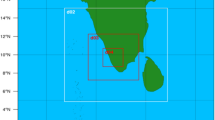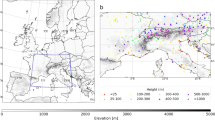Abstract
This study investigated the correlation of thermodynamic parameters with the regional averaged lightning flash density in southwest Iran based on OTD/LIS observations and reanalysis datasets from 1996 to 2014. In addition, the most important parameters and their domains were identified for explaining the lightning density variance using a multiple linear regression model. The results showed that surface sensible heat flux over Syria and Jordan, CAPE over southwest Iran, sea surface temperature over the Arabian Sea, and latent heat flux over Northeastern Europe are the best parameters to predict the lightning density in winter. While in spring, CAPE over southwest Iran, the surface sensible heat flux over northeast Iran and the Arabian Sea, and air surface temperature over the Saudi Arabian Peninsula are the main factors for predicting lightning density. The regression models explain almost 90% and 93% of the lightning variability in winter and spring, respectively. The local effect of CAPE and low-level wind shear on lightning activity is more important in spring than in winter, indicating that the contribution of local lightning-generating convective activity is higher in spring. The correlation coefficient between humidity indices and lightning density showed that western moisture sources have a more important role in providing moisture to convection and lightning in winter than in spring. It is worth noting that the wind speed of jet streams at 300 hPa is positively correlated with lightning activity in winter, although their contribution to the multiple linear regression model is negligible.











Similar content being viewed by others
Data availability
Lightning products are available from the Global Hydrology Resource Center (GHRC) at https://ghrc.nsstc.nasa.gov, and Reanalysis datasets (ERA5) are available from the European Centre for Medium-Range Weather Forecasts (ECMWF) at https://cds.climate.copernicus.eu.
References
Abreu, L. P., Gonçalves, W. A., Mattos, E. V., Albrecht, R. I. (2020). Assessment of the total lightning flash rate density (FRD) in northeast Brazil (NEB) based on TRMM orbital data from 1998 to 2013. International Journal of Applied Earth Observation and Geoinformation, 93, 102195.
Biswasharma, R., Roy, P., Imolemba, Imlisunup, Samanta, D., Pramanik, G. P., Sharma, S., (2021). Regional variation of electrical and lightning properties of thunderclouds during the pre-monsoon season over the north-eastern and eastern part of India, Atmospheric Research, 260,105683.
Boccippio, D. J., Goodman, S. J., & Heckman, S. (2000). Regional differences in tropical lightning distributions. Journal of Applied Meteorology and Climatology., 39(12), 2231–2248. https://doi.org/10.1175/1520-0450(2001)040%3c2231:RDITLD%3e2.0.CO;2
Cecil, D., Buechler, D., & Blakeslee, R. (2014). Gridded lightning climatology from TRMM-LIS and OTD: Dataset description. Atmospheric Research, 135–136, 404–414.
Chate, D.M., Tinmaker, M.I.R., Aslam, M.Y., Ghude, S.D., (2017). Climate indicators for lightning over sea, sea-land mixed and land-only surfaces in India. International Journal of Climatology. 37, 1672–1679. https://doi.org/10.1002/joc.4802.
Christian, H. (2003). Global frequency and distribution of lightning as observed from space by the optical transient detector. Journal of Geophysical Research, 108, 4005.
Damase, N.P., Banik, T., Paul, B., Saha, K., Sharma, S., Kumar De, B., Guha, A., (2021). Comparative study of lightning climatology and the role of meteorological parameters over the Himalayan region. Journal of Atmospheric and Solar–Terrestrial Physics, 219, 105527.
Dayeh, M. A., Farahat, A., Ismail-Aldayeh, H., Abuelgasim, A., (2021). Effects of aerosols on lightning activity over the Arabian Peninsula. Atmospheric Research, 261, 105723.
Fan, J., Zhang, R., Li, G., & Tao, W. K. (2007). Effects of aerosols and relative humidity on cumulus clouds. Journal of Geophysical Research, 112, D14204.
Jaramillo, B. A., Marwan, N., Poveda, G., & Kurths, J. (2018). Nonlinear interactions between the Amazon River basin and the Tropical North Atlantic at interannual timescales. Climate Dynamics, 50(7–8), 2951–2969.
Keikhosravi Kiany, M., Masoodian, A., Balling, R. C., Jr., & Montazeri, M. (2020). Evaluation of the TRMM 3B42 product for extreme precipitation analysis over southwestern Iran. Advances in Space Research, 66, 2094–2112.
Kirshbaum, D. J., Adler, B., Kalthoff, N., Barthlott, C., & Serafin, S. (2018). Moist orographic convection: physical mechanisms and links to surface-exchange processes. Atmosphere, 9(3), 80. https://doi.org/10.3390/atmos9030080
Lavigne, T., Liu, C., & Liu, N. (2019). How does the trend in thunder days relate to the variation of lightning flash density? Journal of Geophysical Research, 124, 4955–4974. https://doi.org/10.1029/2018JD029920
Li, J., Wu, X., Yang, J., Jiang, R., Yuan, T., Lu, J., Sun, M., (2020). Lightning activity and its association with surface thermodynamics over the Tibetan Plateau. Atmospheric Research, 245, 105118.
Marengo, J.A., & Espinoza, J.C. (2016). Extreme seasonal droughts and floods in Amazonia: causes, trends and impacts. International Journal of Climatology, 36, 1033–1050. https://doi.org/10.1002/joc.4420.
Morrison, D. F. (1976). Multivariate statistical methods. McGraw-Hill.
Price, C. G., (2013). Lightning applications in weather and climate research. Surveys in Geophysics, 34(6), 755–767. https://doi.org/10.1007/s10712‐012‐9218‐7.
Qie, K., Tian, W., Wang, W., Wu, X., Yuan, T., Tian, H., Luo, J., Zhang, R., & Wang, T. (2020). Regional trends of lightning activity in the tropics and subtropics. Atmospheric Research, 242, 104960. https://doi.org/10.1016/j.atmosres.2020.104960
Qie, K., Qie, X., Tian, W., (2021). Increasing trend of lightning activity in the South Asia region. Science Bulletin, 66, 78–84. https://doi.org/10.1016/j.scib.2020.08.033.
Rafati, S., & Karimi, M. (2017). Assessment of mesoscale convective systems using IR brightness temperature in the southwest of Iran. Theoretical and Applied Climatology, 129, 539–549.
Rao, V. B., Cavalcanti, I., & Hada, K. (1996). Annual variation of rainfall over Brazil and water vapor characteristics over South America. Journal of Geophysical Research, 101, 26539–26551.
Reeve, N., & Toumi, R. (1999). Lightning activity as an indicator of climate change. Quarterly Journal of the Royal Meteorological Society, 125(555), 893–903.
Romps, D. M., Seeley, J. T., Vollaro, D., & Molinari, J. (2014). Projected increase in lightning strikes in the United States due to global warming. Science, 346(6211), 851–854. https://doi.org/10.1126/science.1259100
Siingh, D., Buchunde, P. S., Singh, R. P., Nath, A., Kumar, S., & Ghodpage, R. N. (2014). Lightning and convective rain study in different parts of India. Atmospheric Research, 137, 35–48. https://doi.org/10.1016/j.atmosres.2013.09.018
Taszarek, M., Allen, J.T., Groenemeijer, P., Edwards, R., Brooks, H.E., Chmielewski, V., Enno, S. E., (2020). Severe convective storms across Europe and the United States. Part 1: Climatology of lightning, large hail, severe wind and tornadoes. Journal of Climate, 33(23), 10239–10261. https://doi.org/10.1175/JCLI-D-20-0345.1.
Tinmaker, M., Ali, K., & Beig, G. (2010). Relationship between lightning activity over Peninsular India and sea surface temperature. Journal of Applied Meteorology and Climatology, 49, 828–835.
Tinmaker, M. I. R., Aslam, M. Y., & Chate, D. M. (2015). Lightning activity and its association with rainfall and convective available potential energy over Maharashtra, India. Natural Hazards, 77, 293–304.
Tinmaker, M. I. R., Jena, C. K., Ghude, S. D., Dwivedi, A. K., Islam, S., Kulkarni, S. H., Khare, M. K., Chate, D. M., (2021). Relationship of lightning with different weather parameters during transition period of dry to wet season over Indian region. Journal of Atmospheric and Solar–Terrestrial Physics, 220, 105673.
Unnikrishnan, C. K., Pawar, S., & Gopalakrishnan, V. (2021). Satellite-observed lightning hotspots in India and lightning variability over tropical South India. Advances in Space Research, 68, 1690–1705.
Wang, Q., Li, Z., Guo, J., Zhao, C., & Cribb, M. (2018). The climate impact of aerosols on the lightning flash rate: is it detectable from long-term measurements. Atmospheric Chemistry and Physics, 18, 12797–12816.
Zipser, E. J., Cecil, D. J., Liu, C., Nesbitt, S. W., & Yorty, D. P. (2006). Where are the most: Intense thunderstorms on Earth? Bulletin of the American Meteorological Society, 87, 1057–1071. https://doi.org/10.1175/BAMS-87-8-1057
Acknowledgements
The authors acknowledge support from the Atmospheric Science and Meteorological Research Center (ASMERC) and the groups of Global Hydrology Resource Center (GHRC) and European Centre for Medium-Range Weather Forecasts (ECMWF), which provided the data needed for this study.
Funding
The authors have not disclosed any funding.
Author information
Authors and Affiliations
Corresponding author
Ethics declarations
Conflict of interest
The authors have not disclosed any competing interests.
Additional information
Publisher's Note
Springer Nature remains neutral with regard to jurisdictional claims in published maps and institutional affiliations.
Rights and permissions
About this article
Cite this article
Rafati, S., Fattahi, E. Effects of Regional Thermodynamic Parameters on Lightning Flash Density as an Indicator of Convective Activity Over Southwest Iran. Pure Appl. Geophys. 179, 2011–2025 (2022). https://doi.org/10.1007/s00024-022-03002-2
Received:
Revised:
Accepted:
Published:
Issue Date:
DOI: https://doi.org/10.1007/s00024-022-03002-2




